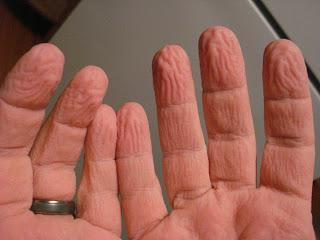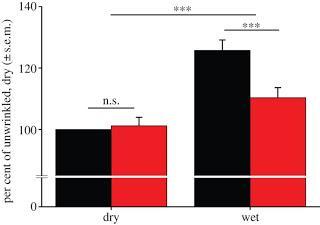 If you sit in the bath for more than 10 minutes or so, you'll notice that your fingers get wrinkled like a prune. People thought for a while that this was a local response to the wet conditions, but it turns out the wrinkling is an active, neurally controlled process. In 1936 two scientists observed a boy who had suffered some temporary damage to the median nerve; he lost feeling in his thumb, index and middle finger and, surprisingly, those fingers didn't wrinkle in the wet. There's a great post on this case and some more recent work here.
If you sit in the bath for more than 10 minutes or so, you'll notice that your fingers get wrinkled like a prune. People thought for a while that this was a local response to the wet conditions, but it turns out the wrinkling is an active, neurally controlled process. In 1936 two scientists observed a boy who had suffered some temporary damage to the median nerve; he lost feeling in his thumb, index and middle finger and, surprisingly, those fingers didn't wrinkle in the wet. There's a great post on this case and some more recent work here.Things that are under active control are usually functional; that is, they're usually doing something useful. In 2011, Mark Changizi and colleagues published a speculative piece in which they suggested that our fingers do not wrinkle randomly. Instead, they noted that the form of the wrinkles match efficient drainage networks, and suggested that perhaps the wrinkles act like rain tread to help water drain away from our fingertips when we grip things.
Fingers form a 'convex promontory', like a hill. Drainage networks on hills have raised sections branching down from the highest point. These raised sections are connected to each other, and separate out troughs along the hill. Changizi et al qualitatively examined pictures of 28 wrinkled fingers and showed that this basic layout is characteristic of our wrinkly fingers too.

Figure 1 (adapted from Changizi et al, 2011). On the left is a satellite photo of a natural drainage network in CA and a schematic of the drainage 'tree'; black lines are the connected raised sections. On the right is an example set of wrinkled fingertips and the comparable schematic
If this is the case, wrinkled fingers should improve our precision grip in wet conditions. Kareklas, Nettle & Smulders (2013) tested this hypothesis with a simple behavioural study. They had people pass small objects from one hand to another to move them from one box to another, and measured the total time it took to do the task. People's hands were either wrinkled or not, and the objects were either dry or in water.
Figure 1. Results of Kareklas et al, 2013. Black bars are unwrinkled fingers, red bars are wrinkled
As you can see from Figure 1, finger wrinkling had no effect on the time to handle all the dry objects. For wet objects, wrinkled fingers led to a significant improvement. Wrinkled fingers aid precision gripping. (Changizi mentioned to me that he's run a similar design and found similar results; nothing published yet).Some thoughts
This makes good sense and these early data are certainly positive. There's a lot still to do, though, to confirm this evolutionary hypothesis. I think a careful analysis of the form of the wrinkles and what happens to the water as the fingers compress on a wet object will answer a lot of the following questions.
The authors of both papers highlight several unanswered questions that demand answers:
- Who else in the animal kingdom wrinkles when wet? Changizi has a picture of a wrinkly macaque but neither paper knows about any of our other relatives, or any other animals. If animals that don't grip show wrinkles, there may be more to it.
- Why aren't we wrinkly all the time? The authors suggest that a) there was no benefit of wrinkles with dry objects and b) there may be some costs to wrinkling - perhaps decreased sensitivity and risk of damage.
- What about toes? They also wrinkle, presumably for similar reasons. It remains to be seen what the functional consequences of these wrinkles are.
- What is the mechanism? Are the wrinkles draining water away? Are they changing some property of the skin, such as the friction coefficient?
It also occurred to me that the drainage networks on hills are shaped by the flow of water over long periods of time; their characteristic form is the result of extensive wear and tear. Our fingertips are actively forming our wrinkles, so while the outcome might be similar the process is very different and this may account for why the wrinkles aren't such straight forward examples of these drainage systems.
It's a fascinating hypothesis about a mundane part of our lives, and I hope someone can take this research forwards in more detail.
References

Kareklas, K., Nettle, D., & Smulders, T. (2013). Water-induced finger wrinkles improve handling of wet objects Biology Letters, 9 (2), 20120999-20120999 DOI: 10.1098/rsbl.2012.0999 Download

